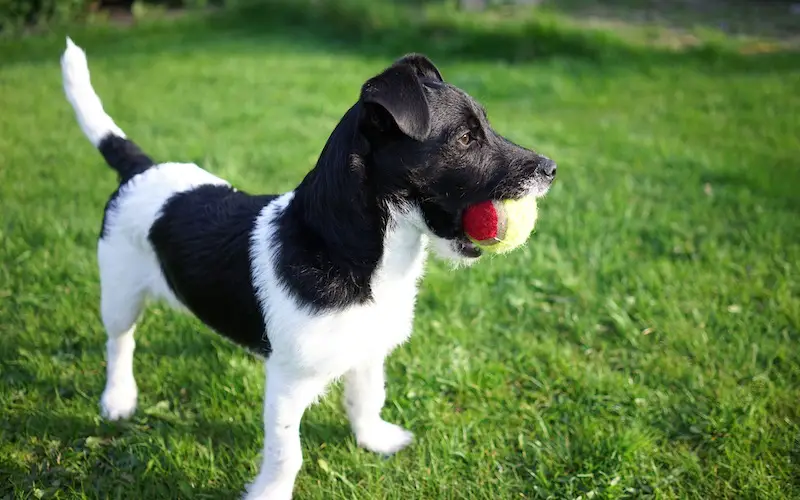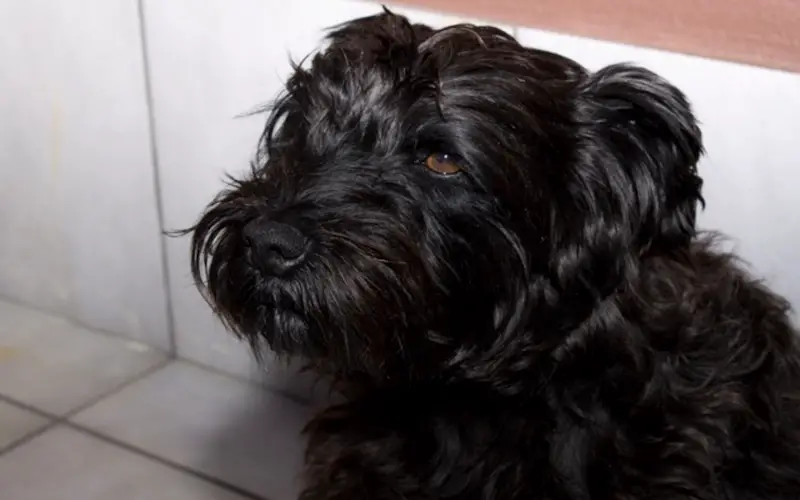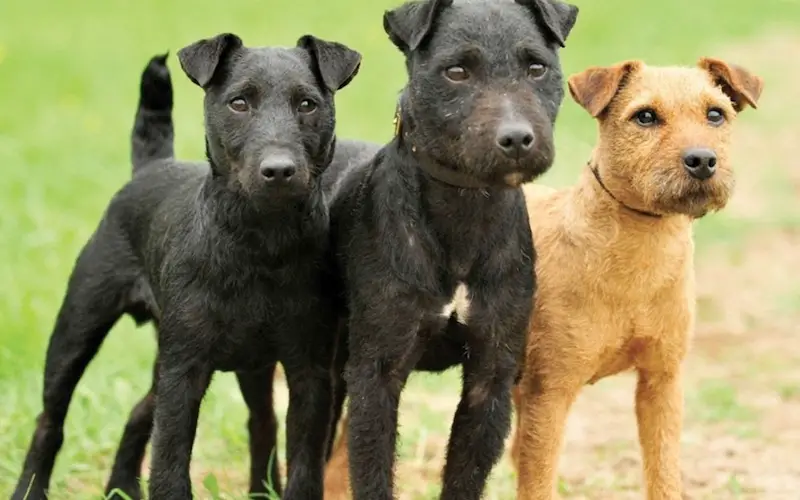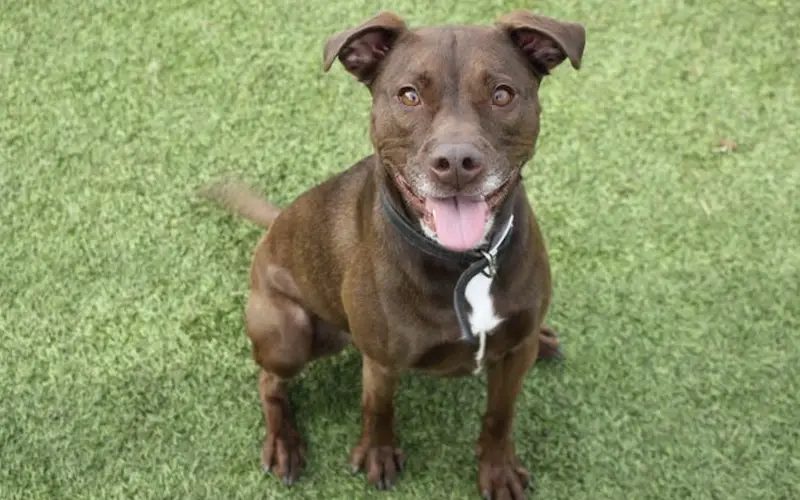patterdaleterriers.co.uk is a participant in the Amazon Services LLC Associates Program and other affiliate advertising programs designed to provide a means for us to earn fees by linking to Amazon.co.uk and affiliated sites. Affiliate links may be used on this page and in patterdaleterriers.co.uk articles, but they do not impact on the price that you pay and they do help me to get this information to you for free. Read my privacy policy for more information regarding affiliates.
There are so many different cross breeds nowadays that they are beginning to be recognized as breeds on their own. Careful breeding has resulted in lots of Patterdale terrier cross variations, as has accidental breeding! They are such a great all-round dog that crossing with compatible breeds has given us some wonderful crossbreeds. Let us take a look at some of the most popular Patterdale terrier cross dogs.
Patterland
The Patterland is a cross between the Patterdale Terrier and a Lakeland Terrier. Both breeds are hunting dogs and have high energy needs. They require a lot of mental and physical stimulation, plus consistent training. Since they have a high prey drive and are naturally inquisitive, their recall is not the best, even with lots of practice, so you must always be aware of your surroundings. They are a small-medium size but full of character. Common coat colours are Black, Tan and Liver. They can be either long or short coated, but usually the hair is coarse. Like Patterdales, Lakeland terries and therefore any crosses of the two, have a range of health concerns including lens luxation, cataracts and Legg-Perthes Disease. This is common in terriers. During growth of hip joints, the blood supply is depleted, causing a deformed ball joint. This can lead to arthritis, hind leg lameness and restricted joint movement. This usually shows at an early age, around 6 months old.

Patterbea

This delightful Patterbea is a Patterdale and a Beagle cross. Another difficult one due to their nature and they will require a firm hand. They are a tenacious breed, at least an hour of exercise daily. They can also be stubborn and, thanks to the beagle side, quite vocal. If the Patterdale has a short coat, then a beagle cross will most likely also have a short coat, although it could be either smooth or coarse. It is more common for crosses to have solid coats, but occasional beagle markings can be seen in litters. They are prone to eye problems like cataracts and glaucoma, plus benign growths and blood sugar issues.
Patterjack
The Patterjack is another Patterdale terrier cross with very high energy needs. These quirky characters are small, but you can’t miss them! They tend to be vocal, especially when walking on-lead and they need socialising early or they can become intolerant of other dogs. These crosses may show some Jack Russell markings, but most will either be solid coats or bi-coloured (2 colour variations). Generally happy dogs, they are prone to little dogs’ problems such as hind-leg limping, knee dislocations and heart issues.

Patterpoo
These lovely dogs are highly intelligent and easy to train. Thanks to their miniature poodle genes, they are low shedding so do not require much grooming and they are a small breed. They are equally like to show physical characteristics of either breed. Although small, they require a lot of exercise. A Patterpoo will make a great companion dog and are not prone to suffering as many ailments as other crosses. Since Poodles and Patterdales do not have markings, a cross between these breeds will show as Black, dark grey, Liver, Tan or White. Thanks to the Patterdale genetics, they may also have a white chest patch. Poodle crosses are prone to bacterial and viral infections, but vaccinations cover most of these.

Chatterdale
A cross between a Patterdale and a Chihuahua, this breed can be quite vocal and protective of their owner. They can also be wary of strangers if not socialise well. Due to their small size, they will need lots of canine socialising as early as possible or they can become intolerant of dogs. They do not tolerate young children well but love the attention of older children who will play and run with them. Like the Patterjack, they are also at risk of joint problems, hind-leg limping and other medical issues associated with small breeds such as spinal problems, tooth and gum disease and kidney stones.
Patton Terrier
This breed tends to show the smooth Boston Terrier coat over the Patterdale qualities and litters are likely to show variations of white markings. They are a small breed but tenacious and needing a lot of mental and physical stimulation. They are also prone to separation anxiety and do not do well with cats but are friendly with other dogs. They are quite easy to train and are very affectionate. Due to the Boston terrier being brachycephalic (flat faced) Patton Terriers can struggle with breathing issues and eye problems like cataracts, glaucoma and corneal ulcers. A small number of Boston Terriers are born deaf in one ear, so this is a risk for Boston cross breeds.
Pocket Pitbull
Do not let the name fool you, the Pocket Pitbull is not a small dog. More on the medium side, they have short and shiny coats and display a lot of the physical appearance of Pitbulls. However, they hold on to a lot of the Patterdale energy and inquisitiveness. They are smart but can also be stubborn so need an experienced dog owner and thanks to their bulky build, they are strong and have a tendency to pull when lead walking. They are prone to a few Pitbull health issues including hypothyroidism and hip dysplasia.

Patterdale/Fell
Since Patterdale Terriers were originally bred from Fell Terriers, there is not much variation in this crossbreed. They are both hunting breeds with high prey drives and an explorer’s nature. Like most working dogs, they require a lot of physical exercise as well as mental stimulation. Due to their breeding, their recall can be lacking as they are easily distracted. Litters will generally not show any markings aside from a white chest patch. Colours will be limited to Black, Dark Liver, Liver, Tan or Red.

Patterdale/Staffy
This cross breed is very similar in appearance and nature to the Pocket Pitbull. Crosses between Patterdales and Staffordshire Bull Terriers tend to have a more staffy appearance, with a short coat and a stocky body. They have a slightly lower energy need than some other Patterdale crosses, but they still require consistent training and can be quite stubborn. Like other staffy type crosses, they are at risk of developing hip and elbow dysplasia as well as hypothyroidism and cataracts.

Patterdale/Cocker
This breed can be a real handful if they do not receive the appropriate level of training from an early age. Both breeds have high energy needs and are prone to lots of behavioural issues if these needs are not met. They are very intelligent, but like other working breeds, have a high prey and scent drive, so recall can be a problem. They tend to have longer coats but can show colours and markings from either breed. A Cocker/Patterdale litter will show a lot of variation.
Cocker spaniels are a high risk of Entropion, which is a condition causing the eyelids to curve inward. Dry eyes, or Keratoconjunctivitis, is also a common ailment. Other issues crosses may suffer from include hip dysplasia, patella luxation, hypothyroidism and hearing loss.
Conclusion
These are just a few of the most popular crosses of Patterdale Terriers. There have been lots of successful crosses of other breeds such as Labradors and Border Collies, showing lots of variation in temperament, physical appearance and personality. Patterdales have quite strong personalities and this tends to show through even with crossbreeds.
It is important to do your research about both breeds, as a crossbreed dog can exhibit traits and characteristics from either parent. Every breed has its limitations and common health issues, so checking this will prepare you in the long run.
As long as you have a lot of time and the physical ability to keep up, a Patterdale Terrier cross is a great dog to have in your home and will give you no end of delight and entertainment.
Further reading, you might enjoy this article on reasons to own a Patterdale Cross and Patterdale Terrier Whippet Cross.
You might also like to read about Can Patterdales live with Cats?


We’ve a patterpoo amazing little dog, very cleaver, gets away with too much !
They are too cute and they know it!!!
where did you get your dog from?
I’ve got a petterdale whippet, a small lady with a massive personality, melts my heart with the little round eyes, almost human she is !!
They all have their own little personalities!
I’ve got a 9 month old patterdale x springer- his previous owner couldn’t manage him- so gave him up – lm getting there with him .. but would welcome any advice from experienced owners ..thanks Tom
We have Peggy a 3 year old patterjack she is amazing and bonkers & so loving but fiesty with other dogs at first meet, we have a 1 year old choc lab max and peggy has had a season and weve tried to keep them apart butttttt?❤️❤️ will him being a large dog hurt peggy if they have mated ? He has stopped chasing her and she is snarly with him could she be in pup i know its early days yet to tell but her demeaner has changed ?
Mating doesn’t usually hurt dogs, even when they mate with dogs of different sizes. If she is uncomfortable or doesn’t want to she will tell him! It is usual for female dogs to get snappy and snarly after their season, and it’s recommended to keep them away from other dogs at this time as it may cause fights (or pregnancy!). As for pups….well time will tell as she will get fatter! But perhaps a trip to the vet wouldn’t hurt if you think she may be pregnant?
Thankyou Amy that was realy good advice and im sure she is fine time will tell ?
Rescued a 2-3week old looks like a patterdale mix puppy she’s really lovable and lets me know when she’s upset when I have been working all day and the other family members have taken care of her. She’s now approximately 5-6 weeks now. And we give her a treat in the living room she goes to the kitchen love her alot.